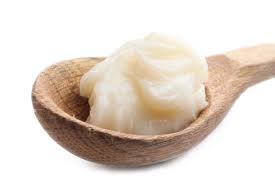
Beef Tallow for Skin: What Dermatologists Think About the Trend
If you’re tired of spending time and money on an elaborate skin-care routine, the beef tallow trend on TikTok may have caught your eye.
That’s right: Beauty influencers are swearing that beef tallow — or beef fat that’s been cooked down to remove moisture and solids, typically used as a fry oil and in soaps and candles — is a natural, cheap, and ancient solution to complaints like acne, dry skin, and scarring.[1]
The hashtag #beeftallow has more than 3K posts, and #beeftallowskincare has more than 1.3K on the platform.
“About a year ago, I realized it literally makes zero sense to have such a complicated skin-care routine, because our skin puts all this effort into producing its own natural oils and its own sebum, yet every night before going to bed we’re stripping it off with all these harsh products,” @thrivewithcandice (23K followers) said in a January 9 video that received 7.3M views.
The creator goes on to say that she no longer uses cleanser but simply dry brushes her face, rinses it with warm water, and applies beef tallow serum to moisturize. “That is literally it,” she says. The method, along with good nutrition, sleep, exercise, and sunshine, has transformed her skin from red and acne-prone to smooth and clear, she says.
But most dermatologists caution against swapping your moisturizer for animal fat, which has little evidence base as a skin elixir.
“Getting these oils from an animal source like beef wouldn’t be my first choice, given concerns regarding contamination, smell, and not being safe for vegan consumers,” says Caren Campbell, MD, a board certified dermatologist in San Francisco, says. “While novelty is all the rage for clicks and likes and follows, ingredients with a long track record of safety are best.”
“I’m not a fan of DIY skin care, nor do I think using ‘natural’ ingredients is better,” Jenny Liu, MD, a board certified dermatologist in Minneapolis, says.
Here’s what else experts want you to know about this emerging trend, before you follow the social media crowd and try it for yourself.
What Are the Purported Benefits of Beef Tallow for Skin?
TikTokers are touting the nutrient makeup of beef tallow, which many pick up from their local health food store in the cooking — not beauty — section. The waxy substance is “extremely rich in retinol, which is vitamin A, and it closely mimics our body’s natural oil,” @santacruzmedicinals (510K followers) says. “After I shower, I take a small amount of this and I rub it all over my face.”
Meanwhile, @maggieroseadvocate (343.7K followers), praises the balm for being rich in vitamins E, A, D, K, and omega-3 and omega-6 fatty acids. “There’s a reason our ancestors did this!” she says.
They’re not entirely wrong, says Joshua Zeichner, MD, an associate professor of dermatology at Mount Sinai Hospital in New York City.
“There’s little harm to applying beef tallow to the skin, although there certainly are more cosmetically elegant, well-formulated moisturizers to get the job done,” he says, adding that the substance does indeed contain the same types of fats found naturally in the skin’s outer layer.
“By applying it to the skin, it provides emollient benefits to soften rough cells on the skin‘s surface [as well as] hydration benefits,” Dr. Zeichner says.
Benjamin Knight Fuchs, a registered pharmacist, nutritionist, and skin-care chemist in Boulder, Colorado, says that beef tallow, which is largely made up of saturated fat, may also provide some benefits because of its cholesterol and fatty vitamins.
For example, vitamin A, aka retinol, is important for skin health, and synthetic forms are known to fight acne, psoriasis, warts, premature aging, and even fine lines and wrinkles.[2] And omega-3 and omega-6 fatty acids are indeed anti-inflammatory, notes research.[3]
But just because something contains vitamins that are good for the skin doesn’t mean it’s made in a way that the skin can absorb safely — or is made better than well-studied and regulated products. “As far as cellular activity and overall skin health benefits go, there’s very little reason to recommend [beef tallow],” Fuchs says.
Beef Tallow vs. Retinol
The claim that beef tallow rivals retinol is faulty, too. While beef tallow’s potential benefit is as a moisturizer, retinol works by sinking beneath the top layer of skin to neutralize free radicals, or dangerous molecules that attack other good molecules that promote essential body functions. “They are not an apples for apples swap,” Dr. Campbell says.
“No one who understands the chemistry of ingredients or the biology of the skin would ever say tallow is even remotely as effective or functional a skin-care ingredient as retinol,” Fuchs adds.
Finally, the argument that beef tallow is safe and healthy to slather on because it’s “natural” and has been used for generations doesn’t hold water (or in this case, fat). Other plant-based oils more commonly used in skin-care products, like olive, coconut, and sunflower oil, are natural too, Campbell says.
Fuchs puts it more bluntly: “Cow manure is also natural,” he says. Similarly, toxic substances like mercury, lead, and arsenic “have been used throughout history, but that does not mean that they’re effective, healthy, or beneficial skin-care ingredients,” he explains.
Potential Risks of Beef Tallow for Skin Care
In addition to falling short of TikTokers’ claims, beef tallow may pose risks for beauty enthusiasts. Namely, since it’s not regulated as a skin-care product by the U.S. Food and Drug Administration (FDA), it could be contaminated or pose unknown allergy risks to users, Campbell says.
Plus, Dr. Liu says, “oils in general are just occlusives, but not as good as a petrolatum at reducing water loss, and may cause other skin issues like irritation or reaction.”
If you do want to try it, you’re better off opting for a beef-tallow-infused balm formulated for skin care than a jar plucked straight from the grocery store. The latter poses a real risk to clog pores and shouldn’t be used as an acne treatment, given its high levels of oleic acid, says Zeichner, who recommends sticking to benzoyl peroxide for acne instead.
For beef tallow products formulated for skin care, Campbell suggests looking for products that say “non-comedogenic,” since that means they’ve been tested to not clog pores, though that claim is not FDA regulated.
Ultimately, she says, there’s a lack of research showing tallow is superior to other oil sources for skin. While one study showed that multiple oils, including beef tallow, showed promise in treating eczema, there was no way to parse which oil or oils in the combination provided the benefit. Plus, that study was conducted in mice.[4]
It will be impossible to know if beef tallow is a helpful skin care ingredient “until studies on only tallow are pursued,” Campbell says.
The Takeaway
Beef tallow is beef fat that has been cooked down to remove moisture and solids. It’s typically used as a fry oil for soaps and candles, but it has taken social media by storm as a skin care alternative, with Tiktokers using it to replace previous routines and suggesting it can provide benefits against skin ailments such as acne, dry skin, and scarring. Dermatologists advise that there is little scientific evidence to support the use of beef tallow as a skin-care product. It is also an unregulated product in terms of skin-care usage and could cause irritation rather than any benefits.


